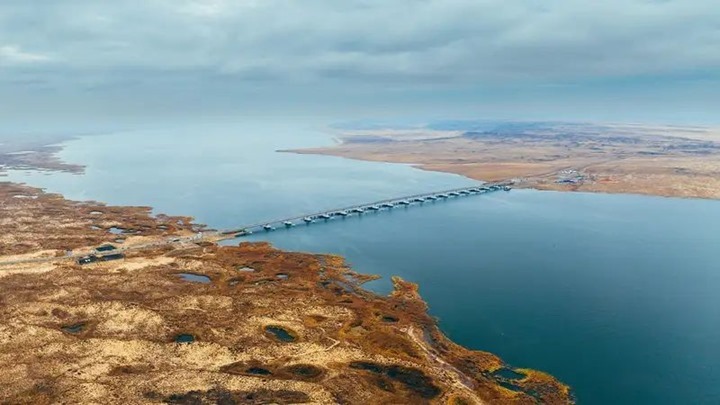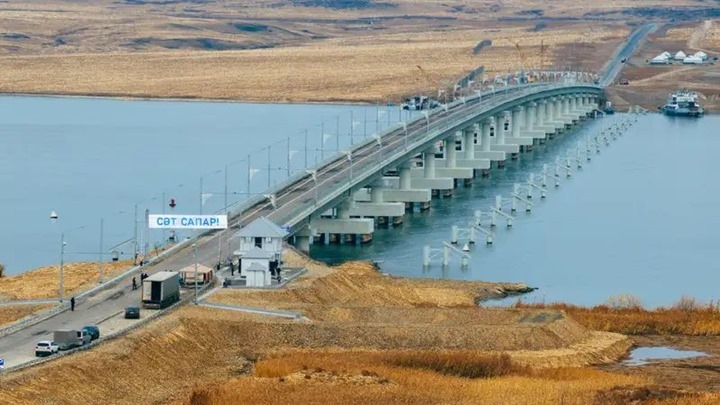How the Bukhtarma reservoir affects the Irtysh and the nature of Kazakhstan
What unites energy, agriculture and the ecosystem? The answer lies in the Bukhtarma reservoir, the largest artificial reservoir in Kazakhstan by area. Its length is 425 km, and its greatest width is 35 km. How was the reservoir created and what did it affect?

Bukhtarma reservoir is located in the East Kazakhstan region. It was created in the 1960s. Its filling began with the help of the Bukhtarminskaya HPP dam. The reservoir was put into operation in 1967. The artificial reservoir consists of two sections: the river stretches along the valley of the Irtysh River and Lake Zaisan.
Bukhtarma HPP was commissioned on August 12, 1968. To ensure the passage of vessels through the waterworks, a four-chamber shipping lock was built, which includes upper and lower passageways with mooring walls, as well as a tunnel spillway from the second chamber.
According to the Ministry of Water Resources of the Republic of Kazakhstan, the facility is a multifunctional reservoir, the resources of which are used in energy, water transportation, industry, drinking water supply, fisheries and agriculture. At the same time, the Bukhtarma reservoir has been playing an important role in stabilizing the flow of the Irtysh River for many years, which in turn improves conditions for moving ships.
To begin with, we note that the three largest hydroelectric power plants of Kazakhstan are located on the Irtysh River: Bukhtarma HPP, Ust-Kamenogorsk HPP and Shulbinskaya HPP. They produce a significant part of the country’s hydropower.
According to the expert in the field of water management Manira Alagudzhayeva, at first the Upper Irtysh cascade of the reservoir was designed to regulate the flow of the Irtysh River. In the 1950s, the Ust-Kamenogorsk reservoir of daily regulation was erected, which accumulates water at night, and during the day it releases the volume that the Bukhtarma reservoir discharges.
“But after the Ust-Kamenogorsk reservoir, the Bukhtarma reservoir itself was built in just four years. It is a multi-year regulation, that is, it accumulates water in high-water years and releases more water in low-water years, using reserves accumulated during periods of high water. In general, this is one of the practical tasks of all artificial reservoirs.”
(Manira Alagudzhaeva)
Further in the 1980s, the Shulba reservoir of seasonal regulation was built. It retains water throughout the year, regulating part of the runoff during the spring flood and distributing it throughout all seasons. Together, all three reservoirs work as a single unit, complementing each other and regulating the flow of the Irtysh River.
“In winter, there is usually little water, and the reservoir retains a small volume in order to discharge it at the right moment, since there are industrial facilities downstream that operate all year round. Initially, back in the days of the Soviet Union, the state had such an idea for gradually created reservoirs: to support the operation of large industrial facilities and cities during periods of low water.”
(Manira Alagudzhaeva)
At the same time, she notes that these reservoirs should also discharge water during the spring flood to flood the floodplain of the Irtysh River. And the hayfields of the floodplain, in turn, contribute to the development of agriculture in Pavlodar region.
“Hayfields are located in Pavlodar region in the floodplain of the Irtysh River. The floodplain is a unique geosystem, a specially protected natural area, the height of the grass stand of which can reach two meters. Moreover, these are grain crops – coarse feed. That is, the flooding of the Irtysh River floodplain improves soil quality, increases yield and provides feed for farm animals,” says Alagudzhaeva.
According to her, the Bukhtarma reservoir has been operating in an energy mode, especially in the last few years. In winter, there are increased discharges of water in order to generate electricity from the hydroelectric power station of the Upper Irtysh cascade of reservoirs.
The expert notes that in recent years the floodplain channels and the main channel of the Irtysh River have been silted up, and this year it could not miss the maximum flow rate of 3,500 cubic meters. m /s, which led to the risk of flooding of the city of Semey. In addition, this year the ice drift began much earlier – if years earlier the ice shifted in mid-April, then this year it passed on April 10.
Thus, the Upper Irtysh cascade of reservoirs currently plays an important role in preserving the floodplain ecosystem, developing shipping, agriculture, energy and providing water resources to three strategically important regions of Kazakhstan (East Kazakhstan Region, Pavlodar and Abai regions), explains Alagudzhayeva.
As is often the case near artificial reservoirs, including the Bukhtarma reservoir, recreational areas have been built in recent decades. There was even a case when these zones were flooded. Our interlocutor said that this happened in 2014, when recreation areas were built on the protruding part of the bottom (reservoir bed), which eventually ended up under water.

In October 2024, the longest bridge in Kazakhstan with a total length of 1,316 meters was opened across the Bukhtarma reservoir. The two-lane bridge was built for year-round uninterrupted movement of vehicles between Zharminsky, Katon-Karagaysky, Kurchumsky, Kokpektinsky, Zaisansky and Altai district in the East Kazakhstan region.
It should be noted that the nature of the East Kazakhstan region is amazingly beautiful, and the favorable location of the Bukhtarma reservoir helps attract tourists from all over the country. This place is surrounded by picturesque mountains, has fresh air due to the reservoir and various species of fish.
Currently, private bases, houses, cafes and much more are located on the shore of the reservoir. The reservoir itself is sometimes called the “sea” because of its impressive size. In addition to solving state issues, today the Bukhtarma reservoir has become one of the most favorite places of tourists.
Aimira Muksulova (Zakon.kz )


